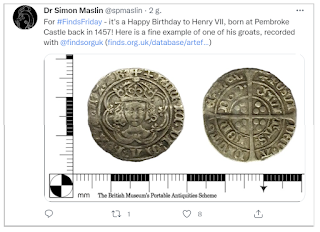A man has been sentenced at Coventry Magistrates court for using a metal detector and causing damage to the protected remains of a medieval castle site after being reported by a member f the public. The culprit left a trail of destruction on protected land at Brinklow Castle, near Rugby (Paul Suart
Metal detectorist picked up by police after digging 30+ holes at medieval castle
coventrytelegraph
05:00, 30 JAN 2022)
A warrant was executed at an address in Coventry where a metal detector, shovel and associated metal detecting equipment were recovered.
A man and woman - neither have been named by police - were interviewed in August 2020 in connection with causing damage to a scheduled monument and the illegal use of a metal detector on a protected site.
The woman was cautioned for destroying or damaging an ancient protected monument while the man was charged to court.
After several adjournments, he pleaded guilty to destroying or damaging an ancient protected monument and possession of a controlled drug during a hearing at Coventry Magistrates’ Court in November.
He was sentenced to an unpaid work requirement of 200 hours (equal to £1,900 at the national minimum wage) and ordered to pay £490 court costs.
His metal detector and associated equipment was ordered to be forfeited and destroyed by the court
But of course, we then get the head-patting:
PC Andy Steventon, from the Warwickshire RCT, said: "We know this person does not represent the majority of the metal detectorist community. True enthusiasts [...] would not go into areas where detecting is prohibited. [...]"
I wonder how many articles about a shoplifter being convicted in Coventry Magistrates Court include a quote from a policeman saying "We know this person does not represent the majority of the shoppers in the city"? Because this is the sort of thing journalists feel constrained to put in almost every article on metal detecting. Almost every one, why? It gets even more puzzling:
Mark Harrison, head of heritage crime strategy at Historic England, said [...]
"The overwhelming majority of metal detectorists comply with the legislation and code of practice for responsible metal detecting [...]".
Well, that's just complete bollocks, unsupported by ANY statistics produced as a result of 25+ years of actual liaison with artefact hunters in England and Wales. Why do people like Mark Harrison keep parroting so repetitively this sort of nonsensical mantra? If the "Head of Heritage Crime Strategy" has no idea of the nature and scale of what he is combatting, then where does that get us? When was the last time there was a
Nighthawking Report in Britain? Oh,
April 2009. As far as I am concerned [see old posts on this blog at the time], that study was not as through as one might expect, and missed a lot. Moreover, the situation in detecting is very different now than it was then.
But Mark Harrison completely muddles in his statement three different things. The "legislation" is one thing, this fluffy Code is another and actual "responsible metal detecting" is yet another. Here's a Venn Diagram showing it.

Which of these areas is Mr Harrison referring to when he says that the "overwhelming majority of metal detectorists" are engaged in "responsible metal detecting"? Because it is not even remotely true, is it, that the overwhelming majority of metal detectorists comply with even the Code of Best Practice for Responsible Metal Detecting, because most of them outright reject it, along with the NCMD. Something Mr Harrison should know. And if he knows that, was he misquoted here, or did he actually say to the public something which is at such variance with the actual facts? A reminder, in 2019, just over 4k individuals reported something to the PAS. 90% of them were MDers, so if there's 27k of them, over 85% of MDers didn't report anything to the PAS (as the Ciode says they should). What kid of a basis for strategy is that?
As for the law breaking, what we know is that few people are caught metal detecting where they should not be. Not every site in Britain is surrounded by houses and roads and has a big notice forbidding artefact hunting on every gate.


































